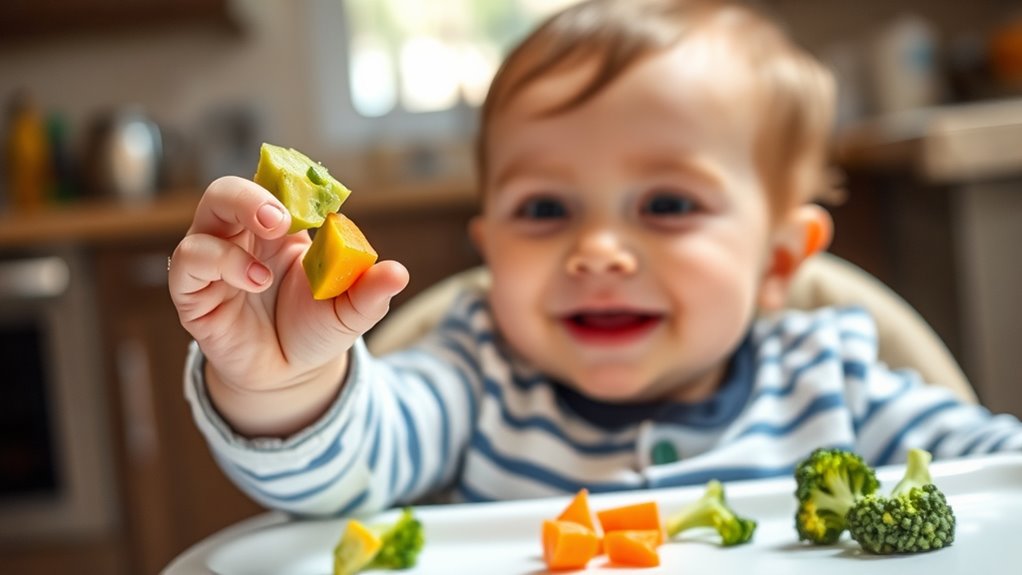Choosing baby-led weaning means your baby skips purees and starts self-feeding with solid foods. This approach helps develop their independence, motor skills, and willingness to try different textures and flavors from the beginning. It also encourages healthier eating habits and self-regulation of food intake. By moving away from purees early on, you support your baby’s growth and exploration. Keep exploring to discover how incorporating tuning techniques can make this progression even smoother for both of you.
Key Takeaways
- Encourages early development of fine motor skills through self-feeding with whole foods.
- Promotes acceptance of a variety of textures and flavors, enhancing food preferences.
- Supports self-regulation of intake, helping babies recognize fullness cues.
- Reduces reliance on pureed foods, fostering independence in eating habits.
- Facilitates smoother transition to solids with tuning techniques and supportive guidance.

Baby-led weaning is an approach that encourages infants to self-feed solid foods from the start, rather than relying on purees. This method promotes independence and helps develop fine motor skills as babies learn to grasp and manipulate different textures. Advocates also argue that it fosters healthier eating habits and better food acceptance over time. It can be particularly beneficial for parents who want to introduce a variety of foods early on. Additionally, some parents find that tuning techniques can be adapted to support babies during the transition to solid foods, making the process smoother and more enjoyable.
Frequently Asked Questions
When Should I Start Baby-Led Weaning?
You should start introducing solids when your baby shows signs of developmental readiness, usually around six months. Watch for abilities like sitting upright and showing interest in food. Instead of sticking to purees, consider offering finger foods to encourage self-feeding and exploration. Starting at the right time helps your baby develop healthy eating habits and motor skills, making the progression smoother and more enjoyable for both of you.
How Do I Prevent Choking During Self-Feeding?
To prevent choking during self-feeding, always supervise your baby closely. Offer food with appropriate textures, avoiding hard or sticky items that are common choking hazards. Cut food into small, manageable pieces, and encourage your baby to chew slowly. Stay attentive and be ready to assist if needed. Making sure food textures are suitable helps your baby practice safe eating habits and reduces the risk of choking.
What Foods Are Safest for Baby-Led Weaning?
Sure, because handing your tiny human a whole apple or raw carrot is the ultimate safety plan, right? In reality, you want soft, manageable foods that reduce choking risks and don’t trigger food allergies. Think steamed veggies, ripe fruits, and small cheese pieces. Stick to predictable feeding schedules to spot reactions early. Always supervise and cut foods into appropriate sizes—your baby’s safety depends on it, not on daring snack experiments.
How Do I Ensure Balanced Nutrition Without Purees?
To guarantee balanced nutrition without purees, focus on offering a variety of foods with different textures, like vegetable chunks and soft meat alternatives. Include lean proteins, whole grains, fruits, and vegetables in your baby’s meals, encouraging self-feeding. You can also introduce fortified foods or supplements if needed. This approach helps your baby develop healthy eating habits while getting the essential nutrients they need for growth and development.
Can Baby-Led Weaning Delay Speech Development?
Imagine a baby exploring textured foods during mealtime; this sensory exploration boosts oral motor skills essential for speech. Skipping purees in baby-led weaning doesn’t delay speech development—in fact, it encourages early oral motor development, helping your baby practice chewing and tongue movements. These activities support language skills, as they foster better coordination and sensory awareness, ultimately benefiting speech. So, your baby’s vocal progress can stay on track with this approach.
Conclusion
By choosing baby-led weaning, you’re giving your little one the chance to explore food independently, which can boost their confidence and motor skills. Did you know that babies who practice baby-led weaning tend to develop better eating habits later on? Skipping purees might seem intimidating at first, but many parents find it rewarding as their babies become more adventurous eaters. Embrace this approach and watch your baby discover a world of flavors and textures on their own!










